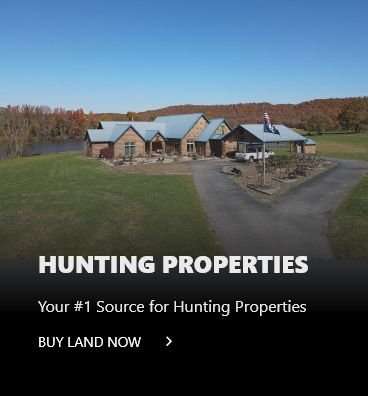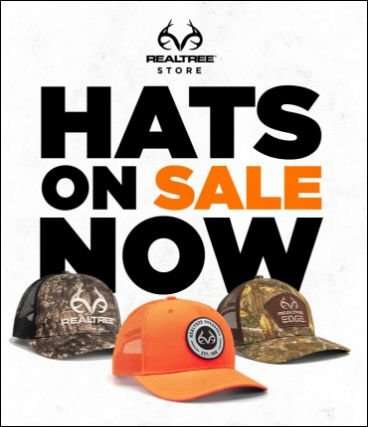From early season to late, and Virginia to Texas, here the strategies southern hunters need to tag big bucks
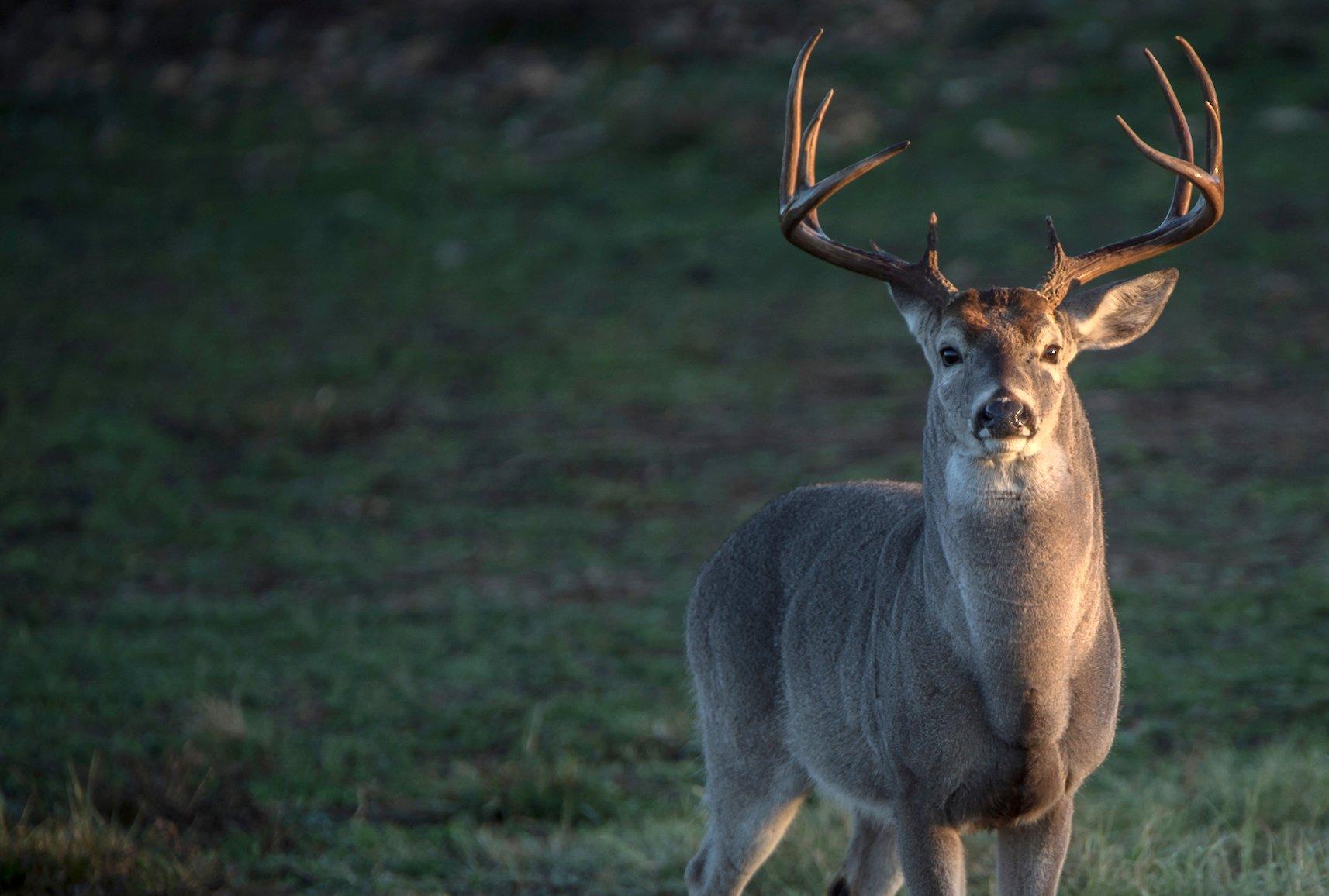
Southern deer are hunted hard and notoriously wary. Image by John Hafner
From Virginia to Louisiana to Georgia, 3 million hunters kill 3 million whitetail deer each season. If you hunt anywhere in the South, shooting at least one doe and a meat buck every year is not a problem. To consistently shoot big deer with big antlers, however, is another thing. I’ve hunted whitetails in 38 states, and can say unequivocally that mature Southern bucks are the spookiest and trickiest of all American deer to hunt.
I grew up chasing these skittish deer and love nothing better than the challenge. Scout, hunt, and smack a 4- or 5-year-old, thick-beamed buck in a swamp or on an oak flat, and there’s no better feeling. To help you do it, check out this comprehensive guide on how to hunt deer below the Mason-Dixon.
SOUTHERN DEER BEHAVIOR
A grizzly old Mississippi guy told me one time, “Boy, our bucks walk around with their noses stuck in the wind, looking up into the trees for us bowhunters.” I don’t know about that, but there’s no question Southern deer are super-wary. They are hunted hard from September or October through January. Coyotes chase and eat them. Old bucks are the ultimate survivors, masters at hiding and working the wind. You’d better be on your best behavior when you hunt them.
Play the wind religiously. Hide your treestands as best you can in cover and shadows. Be quiet. In the Midwest and out West, you can grunt or even yell to stop a buck for a shot. Do that in Alabama and a shooter will come unglued and bolt.
Moreland's extensive research boils down to one thing: Temperature determines whether or not deer, and mature bucks in particular, will be active.
Dave Moreland is a hunter and a biologist who for many years served as Deer Program Leader for the Louisiana Department of Wildlife. When your job is to manage deer in the sweltering Delta, you learn a thing or two about buck behavior in hot weather.
Moreland's extensive research boils down to one thing: Temperature determines whether or not deer, and mature bucks in particular, will be active. Moreland says that on warm to hot days, most deer won’t move much if at all. It's uncomfortable for the animals, and they don't need to feed because they're not burning energy. All of his research projects over decades showed that mature bucks move best on days after a cool front.
I find that bucks in many parts of the South tend to scrape and rub more than deer in the North and Midwest. Research by University of Georgia biologists found that one mature buck can make 1,000 to 1,200 rubs per year, or 10 to 15 per day over a 3-month rut span.
Don’t Miss: ARE THE BIGGEST TYPICAL WHITETAILS HISTORY?
SOUTHERN DEER FOODS
We overthink things. Truth is, 95 percent of deer hunting is learning the top food sources for the animals in your area, locating those foods, and then setting stands along travel corridors from feed to bed. This is true not only early and late in the season, but also during the rut. Find where the does are eating, and you’ll find bucks.
If your bow season opens in September, focus your efforts around late-planted soybeans, or plots of red or ladino clover, perhaps with a chicory mix. In October hunt around a cut cornfield. Above all else, key on freshly falling white oak acorns if present in your area.
Later in November and December, a winter wheat cover crop sown over cut corn is a good deer attractant. Look for red oaks dropping nuts. Brassicas are fall crops that thrive in the mild winters of southern regions.
Keep hunting available crops, clovers, and brassicas into December and January. You can kill a buck late by hunting near leftover acorns and green browse, which is too often overlooked by hunters. For most of the year, Southern whitetails rely primarily on herbaceous plants like Alabama supplejack, greenbrier, blackberry, and lespedeza. Learn the native plants that deer eat in your area. Research shows deer prefer vegetation with a 26% to 32% protein content.
If bait is legal in your state, using shelled corn to attract deer to your cameras and stands is effective anytime, and especially later in the season when other feed is scarce.
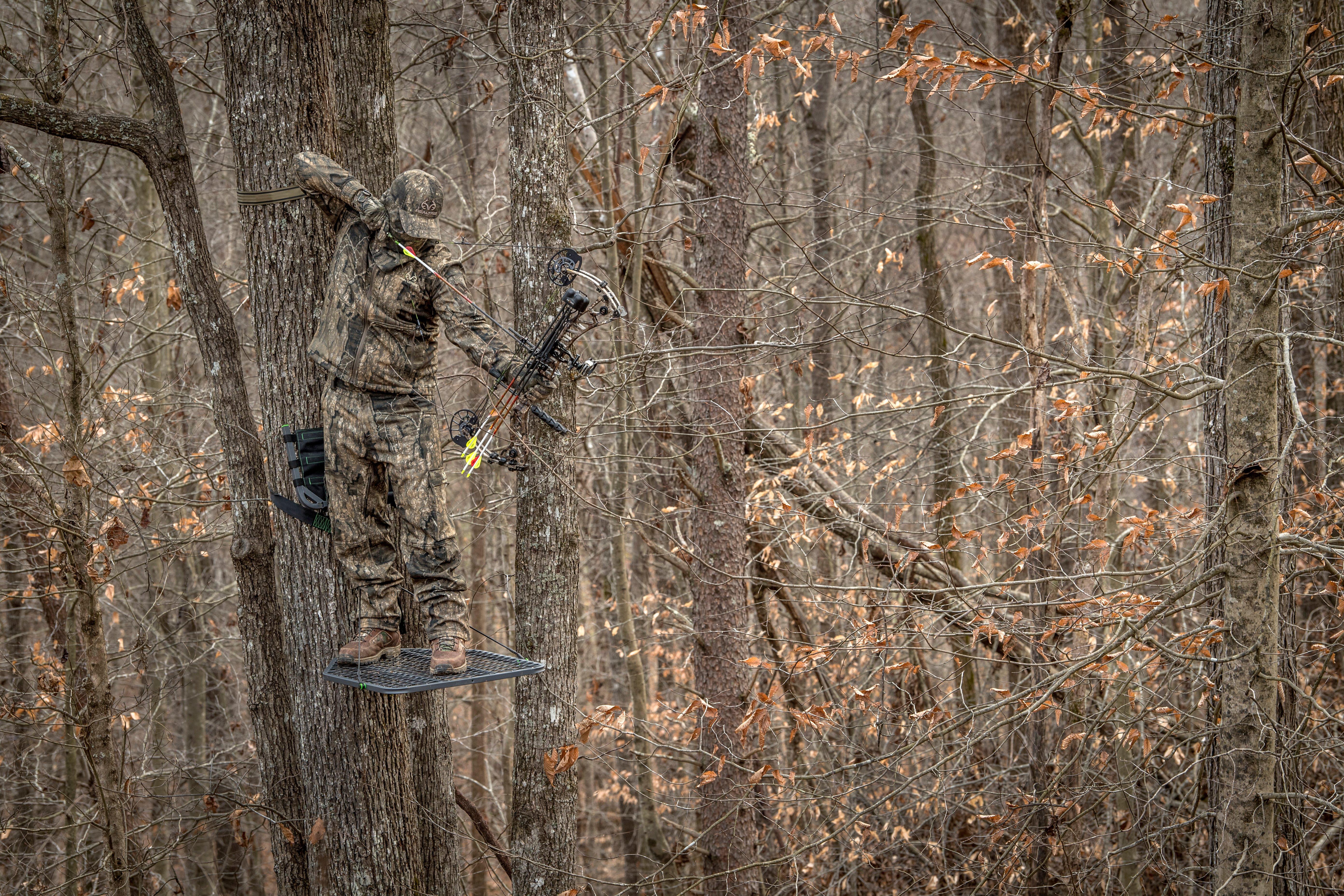
Find key food sources, and set bow stands on the travel corridors deer use to get to them. Image by Bill Konway
SOUTHERN BOWHUNTING TACTICS
If your bow season opens in September or early October, spray down with an odor neutralizer to help negate your sweat, and pack a ThermaCell up into your tree stand. It’s opening week, and you’re raring to go. But remember, these are ultra-spooky deer you’re fixing to hunt for several months. No need to educate them too soon.
Hank Jeffreys lives in south Mississippi and is one of the best bowhunters I know. “From day one, I make it a point to take pressure off the does, especially when I’m hunting around fields and green plots,” he says. “If I can’t get to a stand when the wind and access are right, I won’t hunt that spot. My goal is not to bust a single doe on any hunt. Keeping the does comfortable on your property means more buck encounters during the rut and later in the season.”
Realtree teammate and seasoned Kentucky bowhunter Will Brantley offers a killer setup for mid-September, after bucks have shed velvet, but before bachelor groups bust up for the year.
“If I wanted to guarantee that a hunter saw 10 plus deer in a sit, got a shot at a doe and maybe a nice buck, I'd put them on a major trail just off the edge of a fresh-cut cornfield, like cut the previous day, in a comfortable climbing stand,” Brantley says. “He should be able to see into the field and shoot the edge of it, but set up primarily for a shot on the trail.
“Ideally, it'd be the evening of the first big cold front of the season, with a steady northwest wind, light drizzle and 65 degrees. That's a big change from the 90 degrees that is typical.”
Here in Virginia during opening week in October, my favorite spot for a bow stand is on an elevated ridge situated 70 to 100 yards from a field of soybeans or cut corn. Like most early-fall setups, it is tailor-made for an afternoon hunt, but if access is good and the wind allows it, you can sneak in there and hunt one morning too.
If you have a nice flat of white oaks that runs up to the ridge from the crop field below, jackpot. Does will come from back in the woods and feed there in the afternoon on their way out to the field. Some bucks will come and stage on the ridge or flat in late afternoon before moving out to the crops after dark. If acorns are heavy, the joint will be littered with rubs and the first scrapes, so look for that.
Don’t Miss: ARE TICKS SPREADING CWD?
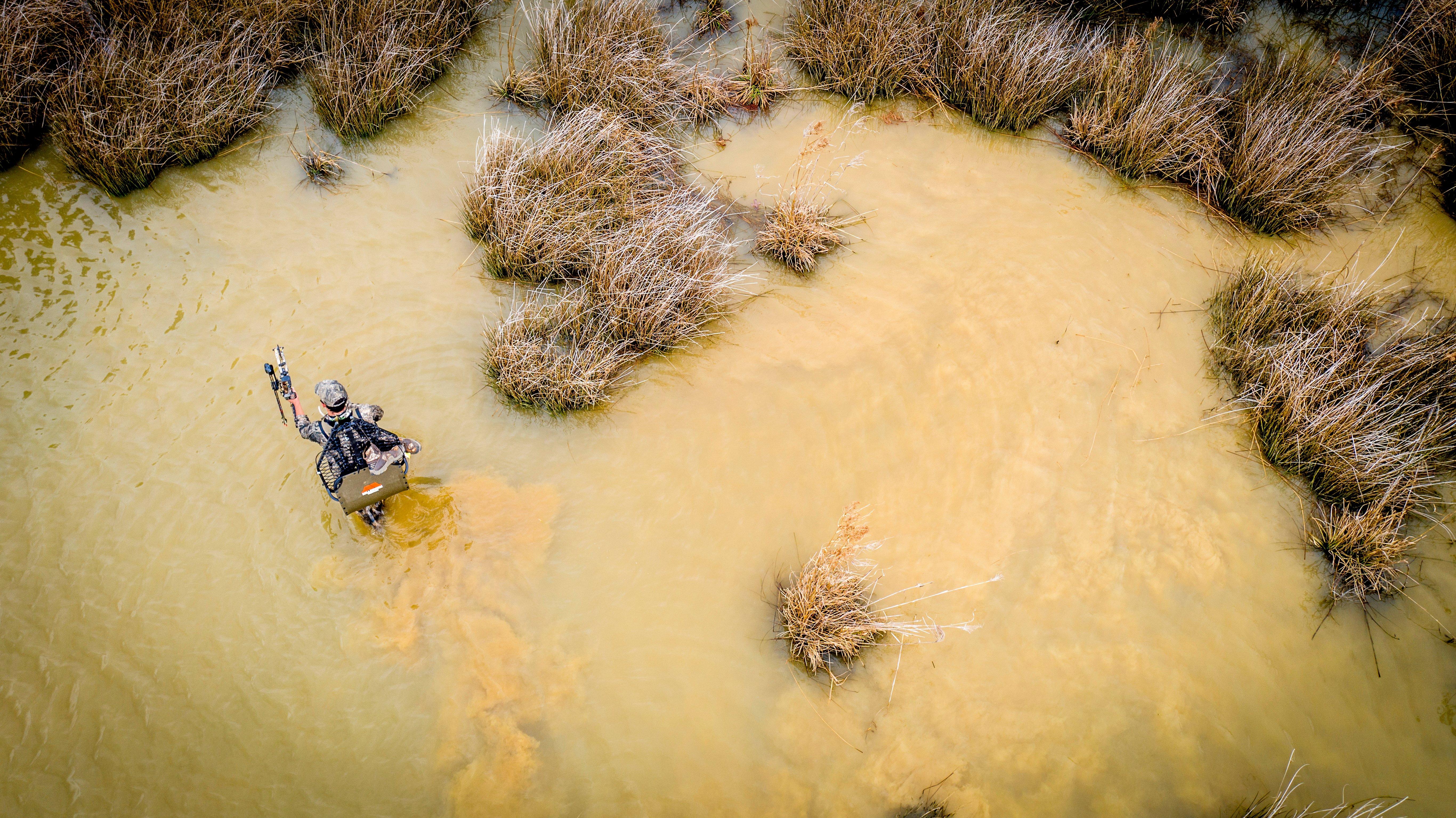
Deer will often bed around wetlands for security. Image by Bill Konway
3 QUICK TIPS FOR SOUTHERN BOWHUNTERS
Say it’s a humid 75 one evening and you’re watching a trail near a field. Stand up in your stand with an arrow nocked the last 15 minutes of light. A buck or even a bachelor group that didn’t move all day might jog past you toward the feed in the last wisps of light. Listen for them coming from back in the woods, and be ready for a quick shot.
You’re sitting in a great stand with three deer trails that crisscross the woods and dump into a clover field 60 yards away. On the trail where the first does show up is where you’ll see 80 percent of the deer that evening. Don’t ignore the other two trails, but key on the primary run.
On ridges where you found the most acorns in September is where you’ll find the first scrapes opened up around October 20th.

Few foods top green soybeans in the early season. Image by N. Nattalli
SOUTHERN RUT HUNTING TACTICS
Midwestern and Northern states have a loosely defined breeding period of 10 days to 3 weeks in November, but it’s more of a strung out “trickle rut” in many Southern regions, especially the deeper in Dixie you go. Deer breeding in the South is extended because of the mild winters; does can drop fawns later in summer and the little deer can survive the next winter.
From late October (Georgia, South Carolina) to mid-November (Virginia, Tennessee, Kentucky) into December (Mississippi) and January and even February (Alabama), expect spotty periods of bucks pushing does for 4 to 7 weeks or longer, with many slow days in between.
While there are some fine managed properties in the South, most people hunt public land or small private woods where the habitat is raw and pretty rough. On these lands, the buck:doe ratio of the herds is typically out of whack (too many does), and that, too, extends the rut. Warm to hot weather is a factor. It may be 70 to 80 degrees and humid for a week or longer; bucks run does in the cooler nights, though you won’t see the action.
Since the deer movement is so variable and unpredictable, I believe your best strategy is to scout well and hang a stand or set a blind in an obvious travel corridor. Hunt that funnel for days and weeks during the extended rut, and sooner or later you’ll see a shooter. Here are two great sets that will work anywhere in the South.
1. A strip of timber between two fields or logging cuts, a long hardwood draw, a twisting, brushy creek bottom… Any long, linear funnel that connects core areas where groups of does bed and feed is a hotspot in the rut. Research of GPS-collared Southern deer shows that throughout the rutting period, bucks make long and linear excursions to maximize their chances of contacting hot does.
2. Set two or three tree stands or blinds several hundred yards apart along a funnel, on the downwind side of trails blazed with scrapes and rubs or, better yet, at the junction of several well-used paths. Try to position on a point or ridge side that commands a good view of a funnel below. Hunt there long enough and you’re guaranteed to see deer; there’s a good chance one will be a shooter buck.
Years ago, I hunted with a man named Joe Champion, who told me about his best stand he was fixing to put me in. “I think I hung it back in the 70s,” said Joe, who at the time managed the hunting on a 15,000-acre paper-company lease. “Lost track of all the 240-pound-plus bucks that stand has produced. To this day you can’t sit there two days in a row in the rut and not see at least one huge deer.”
It’s one of those unique “pinches” you ought to look for in the South, especially if you hunt water country. The stand was tight to the Alabama River. Beaver ponds wrapped around it to create a big timber peninsula. The stand is positioned to cover the stem of dry ground that connects the peninsula to the main woods. When the water is up, the strip is only 2 to 3 feet wide in places. That hardly bothers the black-legged swamp deer, which trample the strip to mud during the rut. “Man, we’ve shot some great deer in that spot,” said Joe, including the 200-pound 9-pointer I killed one January morning.
Don’t Miss: WATCH A BUCK’S ANTLERS GROW
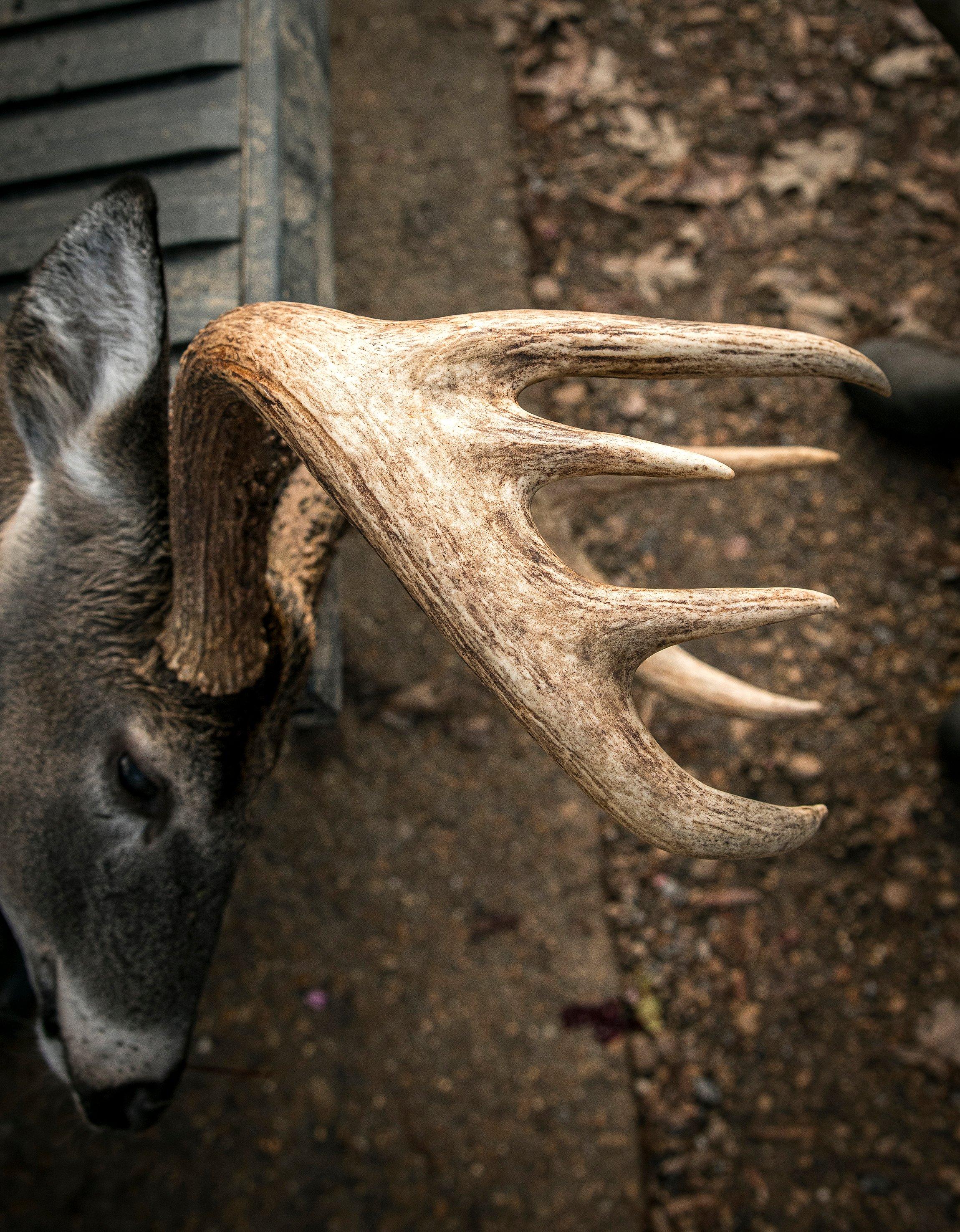
Rifle hunters take 75% of the annual kill in most of the South. Image by Realtree
3 QUICK TIPS FOR HUNTING THE SOUTHERN RUT
A Tennessee study found that bucks love to rub trees along fingers of timber that drop off the sides of oak ridges. Scout those fingers, find the rub lines and hang stands.
University of Georgia research showed that bucks hit one set of scrapes while other scrapes 100 yards away go dormant. Scout, move, and hunt the hottest sign.
A can call that produces doe bleats can lure a prowling buck any day in December or January. Keep bleats short and sweet: meaa, meaa. Back it up with grunts.
Don’t Miss: DON’T LET BUCK FEVER KILL YOU
SOUTHERN GUN HUNTING TACTICS
Across the Southeast, gun hunters register 75% of the annual deer kill. In many states rifle season is a month or longer. Hunters bust deer and shoot some, miss some. Old bucks become ultra-spooky and largely nocturnal.
A South Carolina study focused on blinds set in food plots and over corn feeders. Researchers found that if a stand had not been hunted in the previous five days, deer were attracted to the site. But when a stand was hunted just one day, most bucks avoided that spot for the next three days and often longer. The takeaway: You’d better have a pressure plan for gun season.
The takeaway: You’d better have a pressure plan for gun season.
If you hunt public land or private club ground with 10 or more rifle hunters, let them have the fields, cutovers, creek funnels, and other “best” spots. You check an aerial map on an app and go to the thickest, roughest hell-holes a half-mile or more away. That’s where the big bucks will go to flee the pressure. Here a two great sets.
1. Cover ground and look for a spot where two or three ridges converge and peter out into a secluded creek or river bottom. The nastier the cover the better. Set a stand or blind on a vantage 100 yards or so downwind of a convergence of hills and watch for a day or two. If and when a burly shooter rolls by, take him.
2. In rifle season I look for the narrowest point between a strip of open ground and two blocks of woods or cutovers, and set a stand to cover it. When crossing open ground, bucks will run that choke point between the two timbers or thickets, thereby minimizing their exposure in the open. Stay on your toes and be ready for a quick rifle or muzzleloader shot, because bucks almost always trot from point A to B.
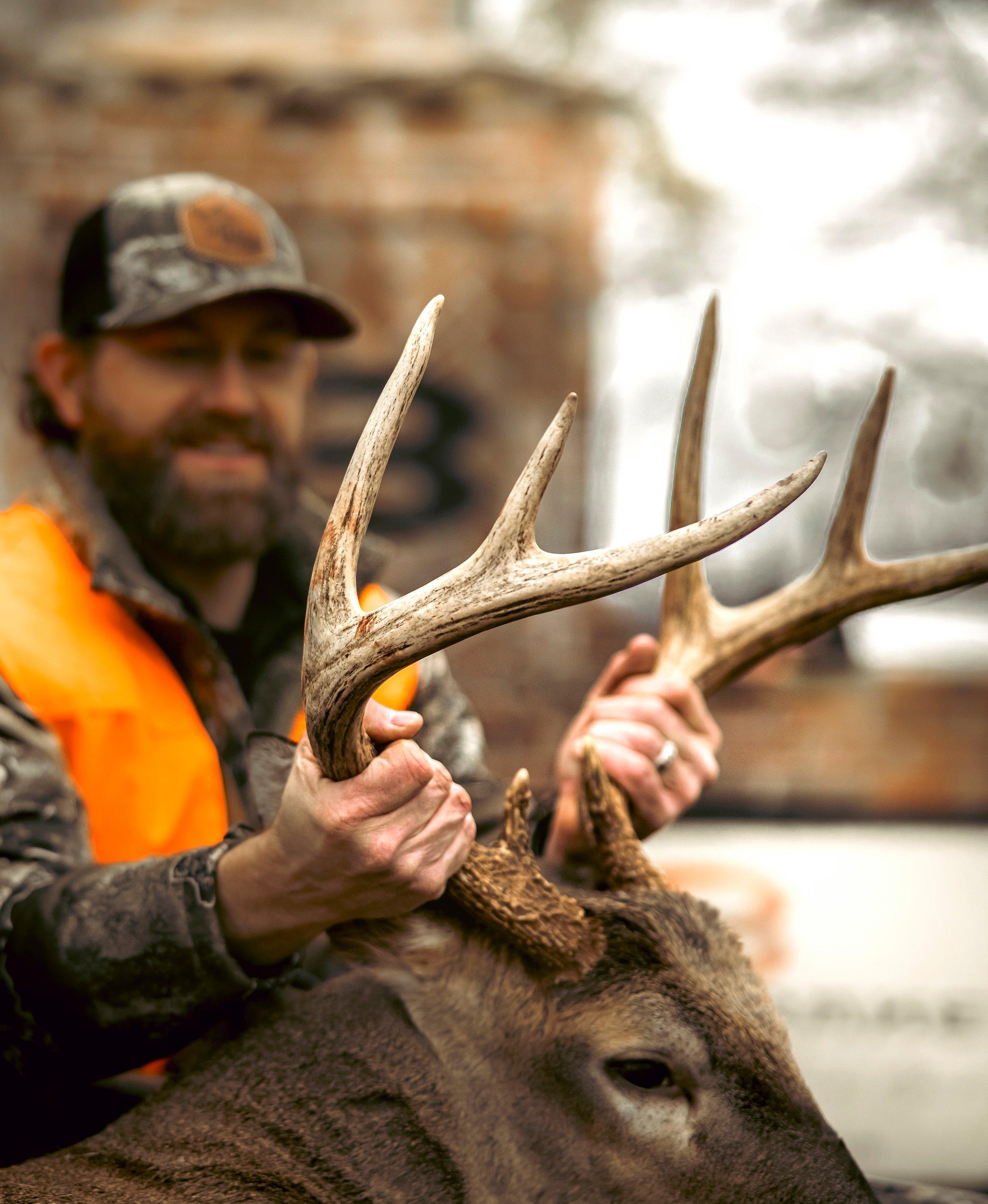
Rifle hunters should focus on stands with a good vantage, and where several travel routes converge. Image by Realtree
3 QUICK TIPS FOR SOUTHERN GUN HUNTERS
Realtree colleague Will Brantley says that when rutting bucks are locked down with does in tiny cover, don't be afraid to move around. “Three of the biggest deer I've ever killed were all on morning hunts in late November, still-hunting with the wind in my face and a rifle or muzzleloader in hand. If you see a mature doe, stop, get set up to shoot and see what happens. A big buck will frequently hold out of sight in cover until she starts to walk away. If he's there, he'll follow her, guaranteed.”
A years-long South Carolina study analyzed 493 deer kills on hunt club land. Hunters used 20 calibers, from .243 to .30-06. As to how quickly deer died or ran after the shot the study found no relationship with increasing or decreasing caliber size. If you want deer to drop on the spot, the study found the shoulder shot is best.
An Auburn study found that if you hunt food plots, do it on opening day. Researchers found that bucks are four times more likely to come to a plot in daylight on the opener than any day later in gun season.
HOW TO DEER HUNT IN TEXAS
An estimated 5.3 million whitetails inhabit 252 of the 254 counties in the Lone Star State. Texas hunters shoot more than 800,000 deer (does and bucks combined) a year. Texas is a southern state, but it has a hunting style and culture all its own. While there are no stats to back me up, I feel confident saying at least 95% of those deer are shot from towers and box blinds positioned to watch corn feeders.
Don’t Miss: FASTEST NEW BOWS FOR 2023
FEEDER AND BLIND STRATEGIES
“This is Texas, feeders have long been part of our hunting heritage,” says my friend Wren Munsterman, who has managed and hunted ranches in all geographical regions of the state.
Wren says, “My main strategy regarding stands and feeder placement is twofold: first, to avoid shooting into a rising or setting sun during the hours of peak deer movement, and secondly, to provide good shots for all types of hunters. Most of our feeders are set up 75 to 125 yards from the stand.”
In the Hill Country and Edwards Plateau, where are there wrinkles in the terrain, place box blinds at higher elevations than the deer trails below. “You want good line of sight into dry bottoms and the sides of ridges,” Wren says. “We clear senderos where possible in dry bottoms and running up the sides of ridges or mesas, or cut openings for feeders in denser cedar brush where mature bucks hang out.”
Farther south in the flatter brush country, Wren and other Texans I’ve hunted with set tower blinds 8 to 12 feet high.
“At each stand we have at least two corn feeders and a couple of 300-gallon water tanks,” he says. If you want to hold numbers of deer on a ranch in hot and arid Texas, you’ve got to have water. If possible, place watering stations every 200 acres across a property.”
Supplement stationary feeders with tailgate feeders. After dropping a hunter off in a stand, the truck driver rolls slowly away and drops lines of corn in open two-tracks out to 200 yards or so. The shooter can watch for a good buck not only at the main feeder, but coming to spokes of corn lines off to each side of it.
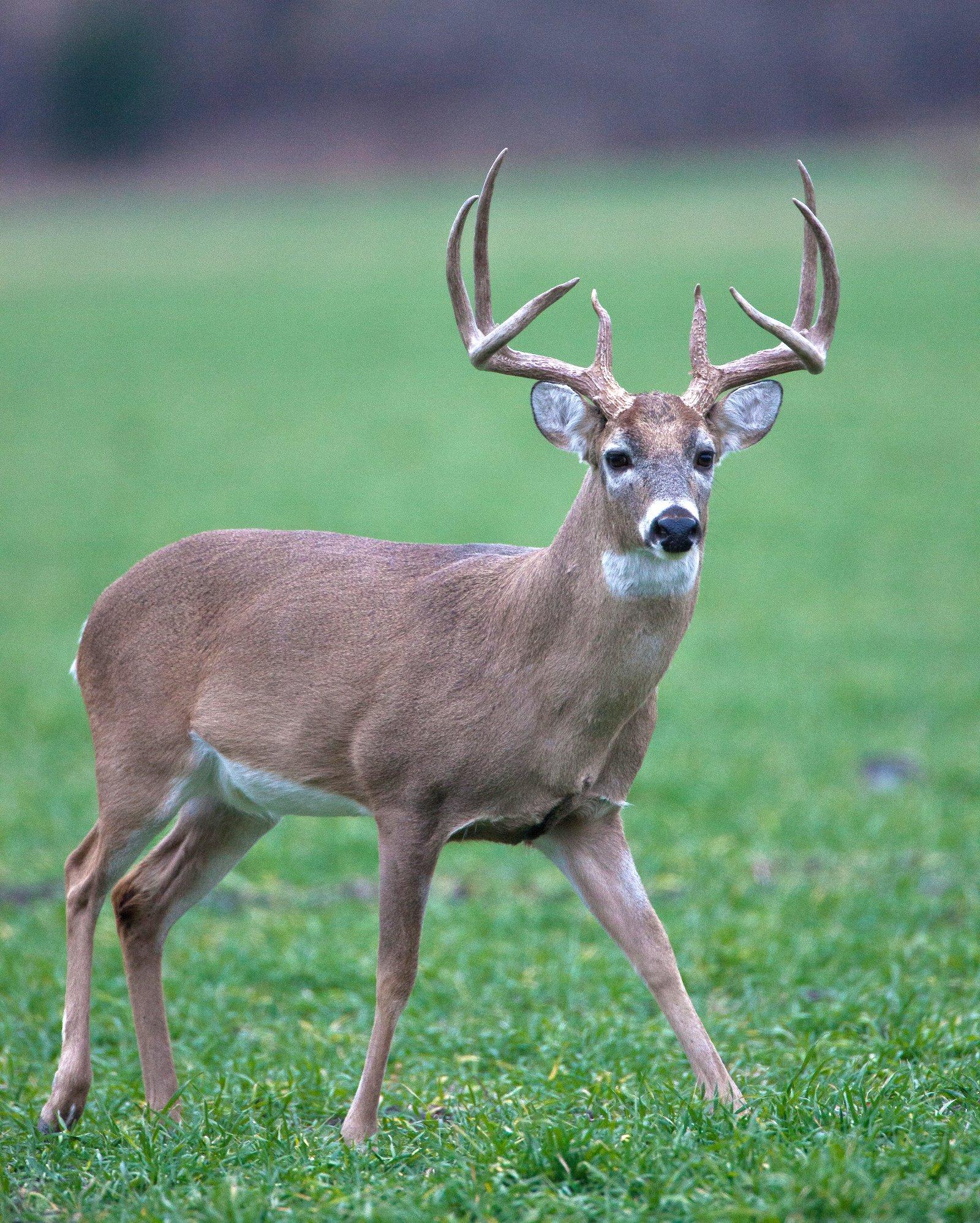
Rattling during the rut can work well in Texas. Image by Russell Graves
RATTLING IN TEXAS
Rattling antlers to simulate bucks fighting over does is another long-standing Texas tradition. If you’re not hunting over a feeder, chances are you’re working the brush and trying to rattle up a buck.
Renowned biologist Dr. Mickey Hellickson conducted a landmark study on antler rattling on a 10,000-acre ranch in the South Texas brush country. His advice is the best you’ll ever get on rattling.
Mick says, “The peak of the rut is by far the best time to rattle in the most bucks, the most numbers.” During the peak rut days, 65 bucks responded to the researchers’ 60 rattling sequences — a 108 percent response rate.
But if you want to rattle up a fully mature buck, try it in the post-rut. Of the 29 bucks that responded to 51 rattling sequences during this phase, 10 were 5½ years old, and another 10 were 3 ½ to 4 ½.
You’ll have your best luck in the mornings. Sixty of 111 bucks (67 percent) that the researchers banged in came to the horns between 7:30 and 10:30 a.m. Cool days with 75 percent cloud cover and little wind speed were best.
“If you aren’t exhausted after a sequence, you didn’t rattle hard enough,” says Mick. He and his crew rattled aggressively 85 times and attracted 81 bucks. Their 86 shorter, quieter sequences pulled in only 30. The length of a rattling session didn’t matter; 1- and 3-minute volleys lured an equal number of bucks.

Above all else, enjoy the hunt. Image by Realtree
3 MORE TIPS FOR DEER HUNTING TEXAS
Many ranches offer “management hunts” for 4-year-old and older bucks with limited antler potential — typically, old deer with 9 points or less that score less than 140. These are the type of bucks I can afford to hunt (the cost is a third that of a trophy hunt) and enjoy hunting the most.
In a study at the Kleberg Wildlife Research Institute, scientists found that deer most often visit a permanent water source (pond, stock tank, etc.) about three weeks after the last measurable rain. Most days, deer get their water needs from green foods or by sipping at temporary sources (rainwater pools in ranch roads for example). But when it’s hot and hasn’t rained for three or four weeks, hunting over a permanent water source is as good or better than hunting a feeder.
Texas bucks are smaller and sleeker than bucks in other parts of the Southeast. Smaller bodies make the racks look bigger at first glance. Look and glass carefully before you shoot. Like a mature buck anywhere in the South, an old Texas deer will look old, with a thick chest, saggy belly and thin hips.
Don’t Miss: HOW TO GET GREAT SUMMER TRAIL CAMERA PHOTOS WITHOUT BAIT OR MINERAL


